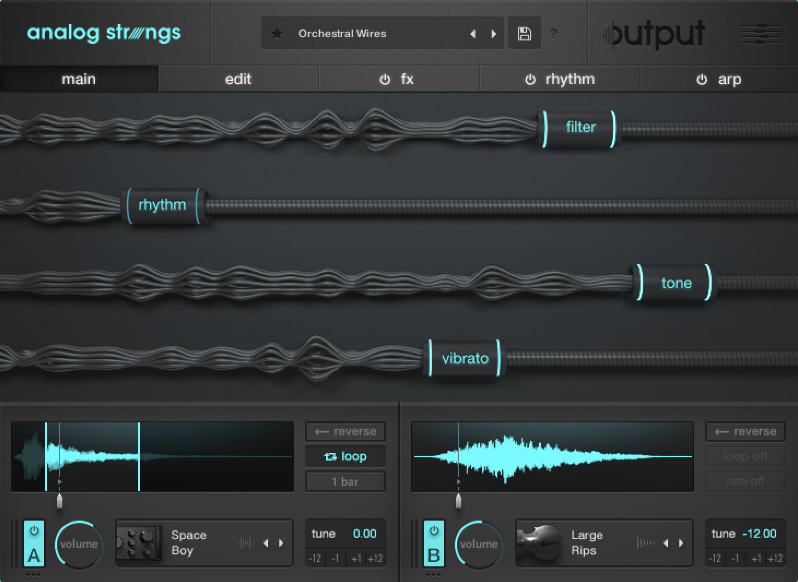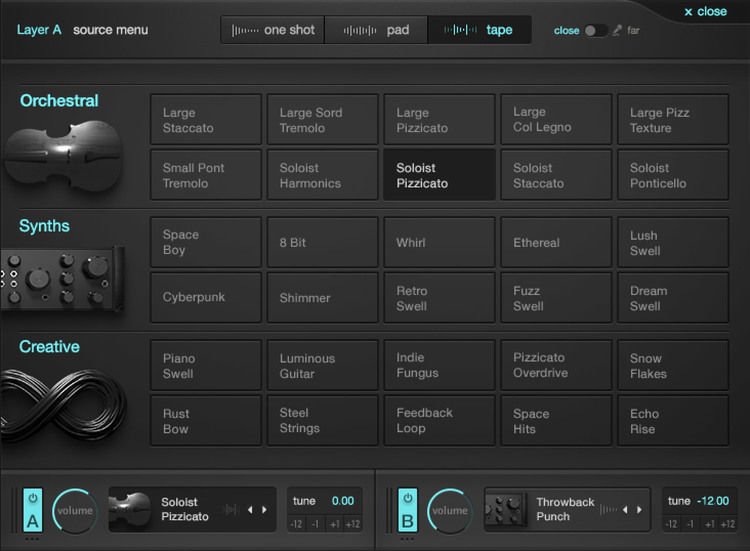New Software Review: Analog Strings by Output

The deep layers of customization available in Output’s Analog Strings make it one of the most flexible and comprehensive virtual instruments on the market.
Analog Strings, the latest release from Output, is a string library that strives to sit in a class all its own.
In testing Analog Strings for myself, I came to find that there is indeed nothing quite like it on the market, with its tactile nuances and novel feature set.
Let’s see what makes it different, and whether it makes sense as an addition to your library.
Features
Analog Strings comes with 500 customizable presets and its whopping 39GB library encompasses samples of as many as 90 recorded sources. In creating Analog Strings, Output sampled a 60 piece orchestra, a 22 piece orchestra, and a handful of soloists. They have even gone to the trouble of sampling their own original—and more unconventional—string sounds, which lend themselves to use in sound design or atmospheric work.
In addition to all of the acoustic instruments, Output sampled many vintage synths and processed them in an unconventional manner to provide you with fresh sound design elements. Also included is a special category of even more unique sound sources like plucked piano, tape noise, distorted guitar feedback, and a wide variety of tape affects.
Analog Strings’ main GUI has a series of customizable macro sliders that give you control over a plethora of parameters including Rhythm, Spread, Filter, Shape, Attack, Delay and more. You can have as many as 4 of these displayed at once on the Main page, with deeper customization available in the Edit pages.
There is also an “Advanced Edit” area that features controls for tools such as dual tape loopers, dual arpeggiators, and flux sequencing, along with the ability to manipulate select modulation parameters. As if this isn’t enough, you still have the ability to create and save custom patches and dive even deeper into crafting their own individual expressive sounds.
In Use
As you toggle through the 500 presets in this sprawling wonderland of a sound library, I would advise using the “Favorites” button. Adding a little bit of organization to your workflow goes a long way with this much content, and Analog Strings’ super-clean layout makes this easy to do.
We have all lost countless hours going down the rabbit hole in search of a sound before we find something usable. Thankfully, the patches provided are grouped neatly into categories, and can even be navigated to by the user-created Favorites, indicated by a star next to each title.
There are lots of twists on old staples with patches like “Harpsicloud,” which are refreshing and welcome takes on some of the more standard patches you may encounter elsewhere. When you have been browsing libraries for years, you may sometimes find yourself skipping over patches with certain titles because you may assume that you know what it sounds like. With Analog Strings, you think you know… but be prepared not to.
All samples in Analog Strings are well-recorded, implemented, and organized. You can find everything from cinematic swells, trills, mashups of analog synths, and brand-new hybrid imaginings of conventional orchestral instruments. Output have even injected some humor into the naming of certain presets with things like, “Unusable But Funny”.
Each patch is unique in how it interacts with your controller, and in order to get the most out of it, it’s important you learn to work with Analog Strings in a tactile way. This is especially enjoyable if you are a musician who thrives on the kind of expressiveness available from a traditional acoustic instrument, or an electronic musician who manipulates their electronics as if they were an acoustic instrument.
Many libraries only start to hint at this kind of advanced tactile functionality, but Analog Strings seems to have been created for it. Some sustained notes have the ability to evolve gradually as the sound progresses, while others are greatly affected by the use of pedals and velocity sensitivity.
The processing tools under the hood of Analog Strings are also quite comprehensive. There are Main, Edit, FX, Rhythm, and Arp menus, which can be toggled on or off individually (with exception to the Main and Edit pages). Within each of these pages are presets designed to let you shape, layer, tweak, and perform the sounds, giving you tons of tonal control. The Main page hosts the macro controls which can also be customized in the right hand corner.
Just below the macro sliders are the “Source” areas. These two sections allow for you to turn sources on and off, control their volume and, most importantly, choose functions like Loop or Reverse and customize where the loop’s start and end points are set. You can even swap out the source sounds if you would like to customize further, or go the extra mile into creating your own user patch.
When you activate the Source area, it opens up a page where all the sources are grouped into types: Orchestral, Synths, and Creative. There are are a variety of sub-categories within each of these groupings, as well as three other options: One shot, Pad, and Tape. In the Orchestral group, an added feature that I found really useful was the ability to move the microphone positioning to either close or far—fantastic for achieving just the right balance.
While on the Edit page, you can adjust the envelope and flutter, as well as have continued access to the source loops where applicable. A feature not to be overlooked on this page is the “Advanced” gear icon; once inside this mini page, there are deeper controls which give you the option to flip the Orchestra from L-R or R-L, as well as change other nuances about the performance. This section also includes controls for where the sample starts, velocity sensitivity, and flutter.
The FX page features two sections: Layer FX and Global FX. Within Layer FX, you can alter the effects applied to each layer, as well as toggle them on or off. Global is similar, but is applied over the entire patch, and has the addition of a Limiter, as well as “Motion” effects, Phaser and Chorus.
The Rhythm tab gives you the ability to toggle each of the rhythms per source on or off, edit the rate per bar, and even have more than one rhythm (as many as four). These controls are cleanly laid out, and at the top of each, next to the “Bar” button, there is also a button for “Flux.”

Analog Strings offers not only a plethora string samples, but also a variety of unique takes on other instruments, and creative ways to augment their sound.
Within the Flux Rate Sequencer, you have the ability to control what kind of rhythmic qualities the sound can take on. Output have also gone to the trouble of adding presets for these… quite impressive!
These can be found just above the source where it says “Rhythm Preset,” and again, you can create your own in addition to using what is provided. These are deeply thought-out features and are at the heart of what makes Analog Strings (and many of Output’s other offerings) behave more like modern instruments rather than mere libraries to be triggered.
Under the “Arp” tab, you have the ability to toggle arpeggiation on or off for either one or both sound sources. Selecting ”Pedal” allows you to choose which note is repeated first in the arpeggiation sequence; Low pedal will trigger the lowest held note between each “expected” or “logical” note in the arp pattern, and High pedal will trigger the highest held note between each “expected” or “logical” note in the arp pattern. There are also additional sequence templates you can use as starting points, such as Reverse, Random, Swing, Duration, and Fixed Velocity, to name a few.
Lastly, Output have included a very succinct take on a “Help” menu by providing users with a “road map” of sorts, accessible under the question mark icon. Though easy to overlook, it is quite helpful—it is a transparent layer overtop of the interface, providing clear labeling and quick details of different components and controls.
To Be Critical
It’s difficult to find anything to be critical of within Analog Strings. The only issue I would raise is that it would be helpful to see which instruments are available deeper within the menus of the Source sounds section. That said, the GUI is very streamlined, and it’s probably for the best that they focused on keeping it uncluttered.
Summing it Up
With Analog Strings, Output have set the bar extremely high for virtual instruments. The expressiveness, quality of recording, and intuitive interface design in this library is hard to beat. I would choose Analog Strings over just about any other string library I have access to, simply based on how quickly you can pull up a usable patch, and how easy it is to customize it—the time saved easily justifies its price point of $199.
Output have also released the Neon Strings Expansion Pack, available for $35, which further adds to the range of sounds and possibilities available within Analog Strings. If you’re a media composer, producer or songwriter, you’d be remiss to not have Output’s Analog Strings in your arsenal. I cant wait to see what they do next!
Kallie Marie is a producer, composer and educator who lives in New York.
Please note: When you buy products through links on this page, we may earn an affiliate commission.






